


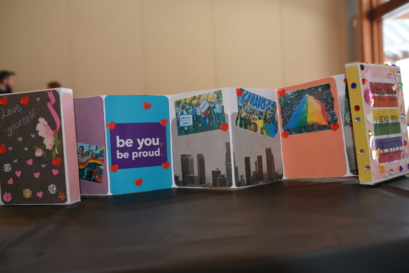
What an honor it was to be at the opening reception of the “Student Creative Expression Exhibit of 2017”. It was the culmination of work of students throughout the Hudson Valley; they worked on pieces expressing “Celebrating Kindness”. For me, the event was both an education and a true celebration!
I learned from Rob Conlon, the Co-Chair of Hudson Valley GLSEN (Gay Lesbian Straight Education Network) that the “Celebrating Kindness” exhibit has been held locally for the last ten years, and nationally for the last fifteen. It is an outcome of “No Name Calling Week” with a more positive spin. It turns out that we in the Hudson Valley, we are a model for the nation!
Hundreds of works of art from students throughout Orange, Dutchess and Ulster Counties were on display. At JFS Orange, we helped to facilitate engagement from students of the GSA’s (Gay Straight Alliances) of Washingtonville High School and the Newburgh Free Academy. Sharyn Alexander, a creative arts facilitator and a Maria Benaissa, Social Work intern opened the doors of conversation, thought and creativity. Most of the students, whose work was on display, were in attendance. It was a cherished moment, to witness these teens being recognized for their work.
Fred Mayo, the President of the Board of Directors of the Hudson Valley LGBTQ Center spoke of his experience of being bullied from early on. Fred went through kindergarten twice, as he “drew outside the lines”. Thankfully, we now encourage people to do so; we respect people as they express who they are! Both GLSEN and the HV LGBTQ Center were critical in organizing the annual event. Thank you to Tess Martin, the Program Specialist and Jake Salt, Director of Programs and Services, along with Rob Conlon, who all did so much in the behind the scenes organizing!
Our program, Teens Connect is made possible through a grant from the Orange County Youth Bureau. We also have support from the County Executive, Steven Neuhaus, who on behalf of the county wrote a proclamation declaring “No Name Calling Week” to be honored in Orange County. The ongoing support of Darcie Miller, Commissioner of Social Services and Mental Health is appreciated. And as an active member of the Cultural Equity Task Force of Orange County, we strongly advocate that it is the right of people from every culture to express themselves and develop in an environment free from oppression.
A tapestry was woven. The students’ individual pieces were part of their school’s submission. And the schools together formed a beautifully curated exhibit. This exhibit will be on display all week-long at the FDR Library and Museum. If you have a chance, I encourage you to go! You will leave inspired and with a smile.
There were so many moving words shared. Quotes from both FDR and Eleanor were recited. I really did get chills hearing many of them. But I’ll leave you with one of my favorites from the Dalai Lama, “Be kind whenever possible. It is always possible.”

read more
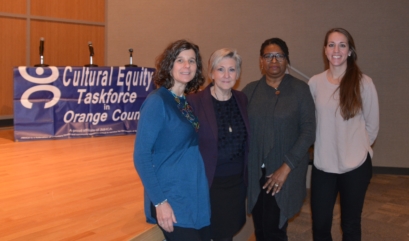
Here we are on Martin Luther King Day. It is fitting for me to sit down and finally share some thoughts about a presentation I attended last month. As a member of the Cultural Equity Task Force of Orange County, I have the honor of serving in the role of Community Training Committee Chairperson. In December, the county hosted three brilliant women to discuss the topic in which this blogpost is titled.
Sandra Bernabei, Cyndi Carnaghi and Tracy Givens-Hunter led the workshop. Though they are well versed in talking about institutionalized racism, they did not come in with all the answers. If anyone had all the answers, we would not need to be having this discussion in 2016. What the workshop leaders brought to the table were many questions; questions that 150 attendees were engaged in answering during our morning together.
Some questions that were asked include:
The room was covered with flip chart paper that was filled with responses. We were all challenged and encouraged to take these questions and discussions back. Back to our agencies, back to the Cultural Equity Task Force, back to our homes, on the lines of the supermarket checkout counter, and everywhere we encounter racism. The beginning of making change is to start with where we are; to have the dialogue where ever we have power. That is where we need to organize!
At Jewish Family Service of Orange County, our mission is to: empower all people facing challenging times to live with dignity, hope and strength. What a perfect opportunity we have as human service providers to ask difficult questions, engage in meaningful discussion and make positive change.
And fitting today, to end this post with a quote from one of our heroes, “the time is always right to do the right thing,” Reverend Dr. Martin Luther King, Jr.
Special thanks to the Trauma Institute of Orange County, JMHCA and funding from Orange County for their sponsorship of this presentation. Photo above left to right: Elise Gold, Sandy Bernabei, Tracy Givens-Hunter and Cyndi Carnaghi.
read more
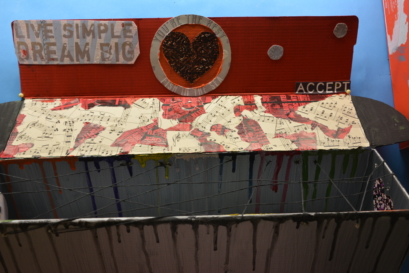
Among the many programs that JFS Orange offers is a program, “Teens Connect.” It is there that we partner with GSA’s throughout the county, supporting youth who identify as LGBTQ and their allies. What are GSA’s? They are after-school clubs; GSA stands for “Gay Straight Alliance.” We are proud to have the support of the Orange County Youth Bureau and during 2016, the Tompkins Charitable Gift Fund. With funding through these sources, graduate level interns, social workers and expressive art facilitators work in area school districts. During the fall months, we facilitate teens in an art project that ultimately will be shown in two venues: in their local high school during “No Name Calling Week” in January and then at the FDR Museum and Library. The Hyde Park exhibition occurs in the spring, along with art pieces of teens throughout the Hudson Valley. The local teens have a chance to work individually, with a group, and then have the experience of being part of something larger.

As much as I can, I like to get out in the field. I love to see our work in action. What an honor it was to see some of the pieces and talk with the teens. The project that one group created was boxes. The outside and inside of the boxes represented different parts of themselves. (The other group is working on accordion books.) I asked some of the youth, what they got out of the project. Here are some quotes they offered:
C, “It was a great experience. I am an ally. I have a lot of family members that are part of the LGBTQ community. Doing this work was a way for me to give back to a community that I strongly support.”
J, “I liked the creative aspect; we got to be expressive. I painted my box all black on the outside, because I seem to hide my feelings. The sparkles on the inside represent the people in my life. They give more light to my life.”
B, “Doing this project helped me to understand more about myself because I had to express my emotions physically instead of keeping them inside. It was interesting to see how different all of our boxes were. It’s fun to see what they represented.”
W, “I was trying to represent me- cool on the outside and really weird on the inside.”
A, “I put a lot of random pieces all together and it fits. It explains who I am. My outside just shows the way I look; the inside shows my authentic self.”
R, “I especially liked the beginning because we all started with the same materials and we all came up with something different. It was so interesting.”
B, “It was fun! It was a different way to express myself. I pretty much used what I found and connected to. I wish this club were more well-known.” [At that time, I informed B. that their spring project would be to organize a conference; my sense is their club would then become more well-known!]
J, “I thought it was fun and I enjoyed doing it. I really like to make things and I like myself. Since this is art, it was right up my alley. In addition, I really like working with my friends.”

At a time that the LGBTQ population is marginalized, it is more important than ever to create a safe space for self-expression and support. Working with the GSA’s is another way that we put our mission into action: “Jewish Family Service of Orange County empowers all people facing challenging times to live with dignity, hope and strength.”
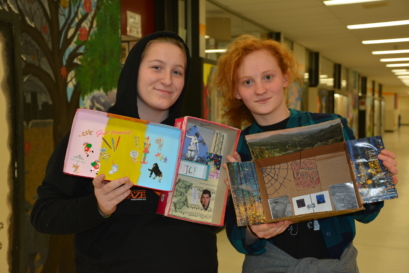

“Empathy.” As a social worker, this word is part of my life’s blood. When I talk with people about what the word, “empathy” means, I am clear that it is not the same as “sympathy.” We are not feeling sorry for a person. Empathy expresses a way of feeling with a person. As best as we can, we try to understand what it is like to be in their shoes, their skin, their heart.
When being empathic, we attempt to quiet our mind. We work on turning down the volume of
Exhibiting true empathy takes discipline. Like any exercise, we need to work to keep this muscle flexed. We
Generally speaking, if a person senses that you are genuinely empathic, it will open the door to a trusting relationship. With this level of trust, sharing will likely deepen.
I recently heard from an adult child of a Holocaust survivor, “we will never understand.” It really hit me; this was tremendous awakening. No matter how much I use every empathic cell in my being, I will never understand. This lesson was a gift. My sense is that when working with Holocaust survivors, I will continue to be as empathic as ever. At the same time, I know, that I will never understand. If appropriate, I will share, “though I am doing my best, I know that I will never understand.” My sense is, that this too, will open doors of a deeper, more trusting relationship.
(Photo is of Toby L. and Rena N. Toby and Rena are incredible women who shared their story of surviving the Holocaust, Resilience and Aging)
read more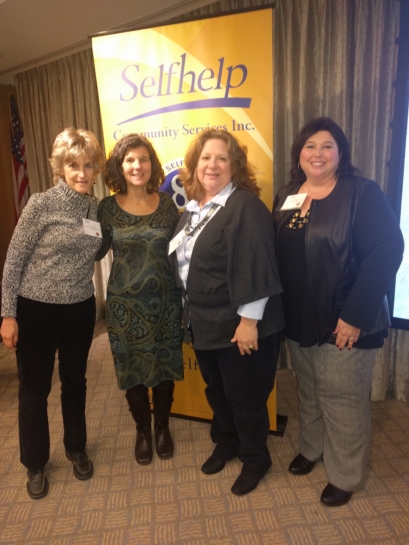
Please take some time to hear reflections of Paula, Liz and Stacy as they share some pearls of wisdom that they learned from the conference. (For more details on the conference, kindly take a peek at our last blog post.) There will be one more story related to our time at this inspirational time in NYC in an upcoming blogpost.
“I was most impacted by the information shared during the workshop: Dehumanization and Empathy: Service Delivery Responses to Holocaust Survivors led by Irit Felsen, Clinical Psychologist. She shared the concept of “Less Human than I” and how the human brain interprets weakness and disabilities as “inhuman”. Those who are physically sick or deformed or emotionally distressed can be perceived, by the brain of caregivers, as “less than human”. She gave valuable tools to combat an automatic response. One of the most valuable tools that she shared is easily accomplished. By finding a photograph of the patient or person in live action at an earlier time in their life and blowing it up to almost life size, by displaying it predominantly in the room where a caregiver would be caring for the individual, it helps to associate the person being cared for with the person they have always been, and not as the helpless or ill person that they may be now. A caregiver automatically relates the image with the person and helps to humanize them.” ~Paula Blumenau, Outreach Coordinator
“I was impressed by the speaker who described how dehumanization occurs and helped us to see how we all lose empathy in relating those who are different from us. Elderly trauma survivors are particularly susceptible to dehumanization because we want to distance ourselves from the ravages of aging and because the disgust we feel for their trauma is put onto the victim. The speaker encouraged us to look for commonalities with others, imagine what they had been like before the illness or loss of ability so that we continue to see them as being like ourselves. In this way, we encourage empathy.” ~Liz Kadesh, Founding Executive Director of JFS Orange and Social Work Supervisor
“I learned that by making a spreadsheet calculating the total reparations a survivor has received throughout their lifetime, this amount should be excluded when determining if a person would be eligible for Medicaid. If a survivor has resources/savings either equal to that amount or less than that amount, these monies are not counted as a resource therefore allowing the person to receive Medicaid. This will prove to be a tremendous source of financial support to some Holocaust people that we serve.” ~Stacy Ocko-Lulkin, Case Manager
read more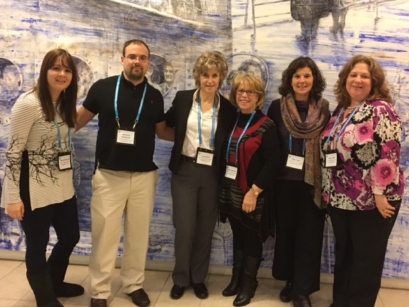
At Jewish Family Service, we are most honored to work with Holocaust Survivors and their caregivers. We have the gift of being awarded grants through different sources. The programs are made possible by funding through Jewish Federations of North America, the Center for Advancing Holocaust Survivor Care, The Conference on Jewish Material Claims against Germany, JFS Rockland and the Jewish Federation of Greater Orange County.
A critical component of serving Holocaust survivors is that as a provider agency, our staff must have a “Person Centered, Trauma Informed” approach. The staff must be knowledgeable in this approach and we also need to teach others who work with survivors about this approach. Several staff and interns of JFS Orange recently attended a two-day conference in which “Trauma-Informed Care for Holocaust Survivors” was the theme. I asked those who attended to share one “take-away” from the conference. This was challenging, as we all came back so inspired. In this blog post, and the next, I will share some of the highlights that I heard from various staff members and interns.
“I enjoyed the conference very much and got a lot from the different speakers. Deborah Courtney, Ph. D, spoke about how we tend to have one fixed approach for every client. We need to make sure to tailor the intervention for each client and we should meet them where they are. That really spoke to me and I thought it was meaningful! Another moment that I really enjoyed was during my breakout group. We discussed group therapy and some people where having a hard time with calling “support groups” a “therapy group.” One person made a great point and said that support groups may not be “group therapy” per se, but that they were therapeutic for the group members; even an intake screening or assessment could be therapeutic for a client and be meaningful. I really enjoyed the overall experience and appreciate the opportunity! Thank you for bringing me in to the conference. ~ Maria Benaissa, BA, Social Work Intern, Adelphi
“The conference was amazing thank you again for inviting us. The first thing that I took away was that to help trauma victims you need to admit you can never understand what they went through. That was so powerful because when you think about it, it’s true. They don’t want someone to pretend they understand; they want someone to help them. I also took away a lot of valuable skills and experience from the group at the end of the day. Hearing from all of the different professionals share what they do and what works for them was great and gave me a lot of ideas going forward in this profession.” ~Matthew Wichlinski, BS, Social Work Intern, Adelphi University
“’Trauma’ and how we process it, was presented in such simple by Dr. Deborah Courtney. I learned that if it’s not processed at the time of the trauma, the fragmented pieces get stuck in processing. The memory and the feeling associated with it get stuck in the hippocampus. We cannot heal the trauma, without healing the body. There are coping skills that can be learned including guided mediation, deep breathing, and learning ways to self-calm.
She also discussed that aside from individual professionals being aware of trauma, agencies as entities need to have a culture of sensitivity. I love the fact that our agency can offer such a supportive environment. We do so much already; it’s great to know that we can always learn more and do more.” ~Doris Rubinsky, Director of Safety Net Programs
I will share more in upcoming blogposts. If you know of a Holocaust survivor who needs and is open to care, please contact our agency. With an open heart, and some additional tools in our tool belt, we are so ready to offer our services. 845.341.1173 ext. 306
read more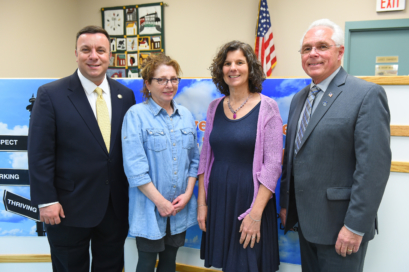
Have you heard of the Olmstead decision? In a nutshell, it came about when two women, Lois Curtis and Elaine Wilson, both with a diagnosis of mental illness and intellectual disabilities were in and out of psychiatric hospitals. When at home, they did not have the care needed. They’d end up in the hospital and the cycle began again. It was evident that they’d be able to do well in a community setting, provided they received the supports needed.
Under the Americans with Disabilities Act, the Supreme Court established that it is against the law for the state to discriminate against a person based on his or her disability. Since I said I’d offer a nutshell version, I’ll share briefly here, that since the 1990’s, efforts have been made to close institutions and institutional settings.
Let us fast forward to this past spring. We were invited to a Town Meeting to express our thoughts on the impact of the Olmstead Act on local communities. The forum was hosted by the Assembly Minority Task Force on Protecting the Rights of People with Developmental Disabilities. Members of the Assembly, Karl Brabenec and Clifford W. Crouch led the meeting. They were eager to give community members and leaders an “opportunity to empower the stifled voices and help create greater awareness of the shortfalls in the current transition process.” When I received the written invitation, and then a follow up phone call, I asked if they were sure that they wanted to hear from me. Indeed they were, no matter what I expressed.
What I shared was that while being in the community is wonderful for some, it is not the be all and end all. There should be no “one size fits all” solution for everyone with disabilities. It is critical that everyone has many options; the key word here is , “choice”. For some, living and working in congregate care settings offers more choice, as there’s a level of freedom to walk around a campus or workshop and socialize with anyone there. For others, community life opens many doors.
I was so impressed by the dialogue that ensued. The clock was not watched as each person spoke their voice. The assembly members reflected as parents, siblings, professionals and community members advocated for their beliefs.
Residential institutions and developmental centers have been closed. Workshop settings are in the process of being transformed. Let us stay tuned as we continue supporting the rights of people with developmental disabilities.
Photo provided. Taken at the Greenville Town Hall in April 2016. From left, Assemblyman Karl Brabenec, Margie Faber, Director of MSC, JFS, Elise Gold, Executive Director, JFS and Assemblyman Clifford W. Crouch
read more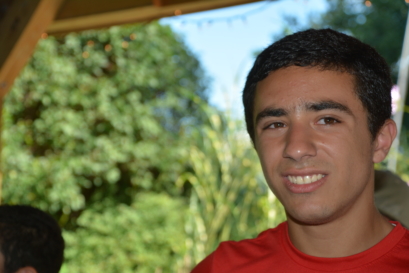
Who better to invite as a guest blogger than, Suzanne Schindler? Suzanne, along with other parents and guardians serve on the JFS KidsConnect Advisory Board. They helped to vision and create the program, from its inception, nine years ago. At that time, it was called, “Yeladeinu”, which is Hebrew for “Our Children”. Please join me in reading Suzanne’s precious words about how KidsConnect impacts Andrew and his family:
“When I think about my childhood summers, memories of fun filled days at camp come rushing to me. Playing kickball, Newcomb, swimming, arts and crafts, laughing with friends, enjoying the outdoors nature walks. Having a good time and enjoying the break from school and enjoy being just a kid. No responsibilities other than having fun! When JFS first started KidsConnect Camp, these were the things I wanted my son and all of the kids in attendance to experience. I wanted my son to enjoy all of the things that I did during my summers at camp. I wanted him to look at pictures and have happy memories of a wonderful time at camp.
My son, Andrew is now 16 and on the autism spectrum. Since he attends a six- week summer school session each year, the only school break he gets is at the end of summer before the new school year starts. He never had a chance to experience summer camp until KidsConnect. Each day at camp is better than the previous day! The smiles and excitement I see in his face is mirrored on the faces of all of the kids attending. The kids come back year after year seeing the friends that they made over the previous summers. The kids have the chance to participate in activities they may never had the chance to do such as Tao Kwan Do or horseback riding. Each child in attendance is teamed up with a teen mentor. The bonding and the experiences for all involved is priceless! An annual family BBQ and campfire is a huge hit as well! S’mores and singing and having a great time!
Andrew is now as fortunate as I was….with KidsConnect; he gets to enjoy his short summer break like any other teen. He experiences all of the fun things of summer that I did. And he probably gets that feeling in the stomach like I did on the last day, knowing that summer is coming to an end.”
The top photo is of Andrew Schindler.

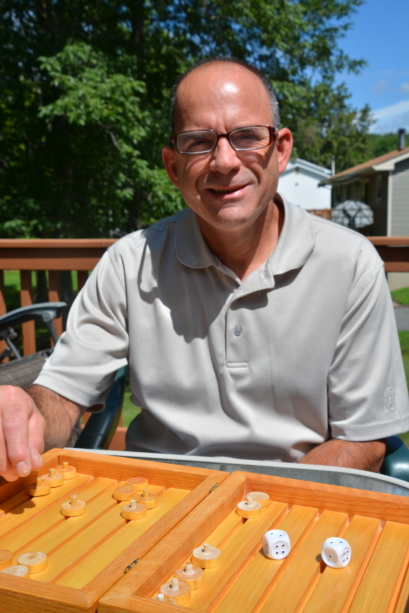
You likely are aware that so much of our funding comes from grants and awards. Last year, we were honored to receive a gift from the National Volunteer Transportation Center. We are applying again this year. As part of the application process for the “STAR Award”, we are required to submit a story written by a passenger who receives rides from the Friendly Visitor Program. Louis Ciccone, of Middletown was eager to share his story for this purpose. I met Lou earlier this week. His story is so inspiring that I was compelled to share it with a wider audience. Thank you, Lou, for giving me permission to be a “guest blogger”! Now, for Lou’s words…
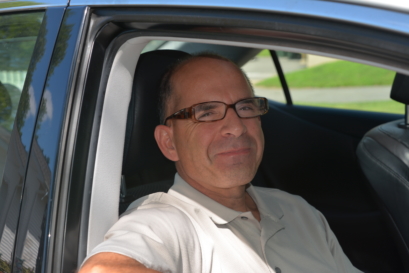
“Transportation in Orange County, NY is virtually nonexistent! It took months to years before I connected with Jewish Family Service’s Friendly Visitor Program. I haven’t driven since May of 2004 resulting from a Neurological Disorder. After several brain surgeries in 2005 the disorder was corrected. Unfortunately, it left me visually impaired. After an extremely long recovery I was ready to return to the workforce. Getting a job was frustrating, traveling to and from was worse. I tip my hat to JFS for making it possible. I was a prisoner in my own home residing in a development, four miles to the nearest bus stop. It’s a losing situation as I desperately searched for rides to work.
I was desperate for help. The one way $20 cab ride inspired me to contact my congressman. After his failure I called the County Department of Transportation. Their answer was to call somebody else. Writing was my last hope. Remarkably, my email to the Lion’s Club found resolve. Doris Rubinsky (a Lion member, and the Program Director for JFS) responded to my plea. This was the breakthrough I hoped for; this was the beginning of stability in my life! The volunteer drivers soon were transformed into friends. I am a lucky man to connect with this organization! I can travel to work and any medical appointments without my wife losing a day’s pay. Here I am one decade later; they continue providing the means to enter the world.”
read more
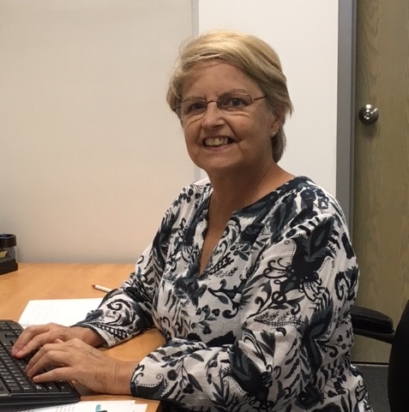
At JFS Orange, we have the honor participating in the “Health Promotion and Mental Services Program.” This unique program falls under the “Community Services for Elderly Program” under the auspices of Orange County Office for the Aging.
Among other responsibilities, Vicki Bedford runs support groups. One area in which so many of us suffer is, how to deal with chronic pain. Vicki is a fierce advocate for self-care. Last fall, in this blog, she shared the importance of hydration. We’re now going to turn to other simple ways that we can take care of ourselves. In four simple words:
Stay active, be distracted!
Tips from Vicki:
It’s a vicious circle… you experience pain and so you don’t feel like taking a walk, or gardening, or joining friends for lunch. So you lay down for a nap, or doze off in your chair. That night you likely will have trouble falling asleep. You’ll toss and turn, then get up later than usual.
Don’t ride that roller coaster! Sleep and engaging in pleasurable activities are key factors in managing chronic pain. Make a date with yourself; plan for some type of activity every day! Maybe it’s vacuuming the living room, or working in the garden for an hour, or walking around the mall. Do what pleases you, but do it and don’t overdo it. It’s important to pace yourself. If 10 minutes of walking is all you can do, it is better than doing nothing at all.
When you are just not able to engage in physical activity, engage your mind. Reading, knitting, jigsaw or crossword puzzles, watching a movie, are all good ways to distract yourself from your pain.
Sleep is a very important factor to our overall wellbeing. Your bedroom should be a sanctuary. Your bedding should provide the right temperature; not too hot or cold. Block out outside light and sleep with lights and electronics OFF.
These are all quite doable. The most challenging part is breaking old habit patterns and getting started. Though these tips are geared to people with chronic pain, they are ideas in which we can all benefit. We’re wishing you the best as you put them into place, and thank you, Vicki!
read more